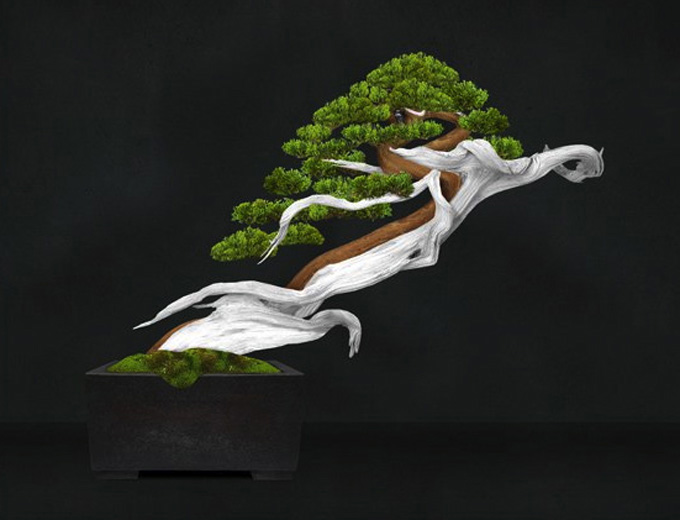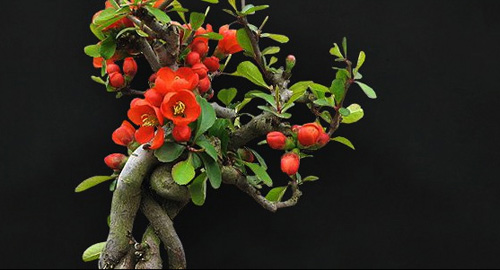 NOTE 3/24/11: I WAS JUST INFORMED THAT THIS IS A SIMULATION OF A MUCH ROUGHER TREE. MY MISTAKE! EVERYTHING THAT FOLLOWS IS WHAT I WROTE BEFORE THE ERROR WAS CALLED TO MY ATTENTION). This is the kind of bonsai that can stir up opinions. I found it on facebook (of course), under My Bonsai by David. Carvalho. If you look closely, you might notice the little concave piece that appears to be missing from the pot.
NOTE 3/24/11: I WAS JUST INFORMED THAT THIS IS A SIMULATION OF A MUCH ROUGHER TREE. MY MISTAKE! EVERYTHING THAT FOLLOWS IS WHAT I WROTE BEFORE THE ERROR WAS CALLED TO MY ATTENTION). This is the kind of bonsai that can stir up opinions. I found it on facebook (of course), under My Bonsai by David. Carvalho. If you look closely, you might notice the little concave piece that appears to be missing from the pot.
What’s your cup of tea?
If you are a big fan of, let’s say Dan Robinson and his remarkably natural looking bonsai (Gnarly Branches, Ancient Trees), then trees like this might leave you cold. However, if you appreciate flowing lines, sharp contrast, dynamic movement and highly stylized foliage, then the type of bonsai art that you see above (and that was pioneered by Masahiko Kimura) might be just your cup of tea.
My not so humble opinion
Not that you asked, but I love Dan Robinson’s raw natural look (Walter Pall’s and others’ too). But I’m also moved by Kimura’s and Carvalho’s (and many others) more abstract, highly stylized trees. When it comes down to it, I don’t think one style negates the other. They can each stand on their own (I also don’t think that bonsai is so simple that it can be broken down into just two types, but that’s a topic for another time).
John Naka’s famous dictum
I think if I had to favor one type, I’d say that the rugged natural look is more pure (whatever that means), especially if you follow John Naka‘s famous dictum: “The object is not to make the tree look like a bonsai, but to make the bonsai look like a tree.” Still, I think there’s room for great diversity in bonsai styles (and in opinions about those styles).
 I think the colors of quince flowers are among the most striking brilliant and pure colors you’ll find anywhere. This photo also appears under My Bonsai by David. Carvalho.
I think the colors of quince flowers are among the most striking brilliant and pure colors you’ll find anywhere. This photo also appears under My Bonsai by David. Carvalho.
Compare our NEW REDUCED PRICES on Concave Branch Cutters
 If you want to prune bonsai, concave cutters are indispensable. They come in many sizes and grades and we (Stone Lantern) have most. From low to high:
If you want to prune bonsai, concave cutters are indispensable. They come in many sizes and grades and we (Stone Lantern) have most. From low to high:
Bonsai Aesthetics 8″ Novice grad Concave Cutters: Was $15.75, now $11.05
Bonsai Aesthetics 11″ Novice grad Concave Cutters: Was $27.15, now $18.90
Koyo Standard 8″ Concave Cutters: was $43.25, now $30.50.
Koyo High Quality 8″ Concave Cutters: was $59.20, now $43.95
Koyo High Quality 6.75″ Concave Cutters: was $55.30, now $40.90
Koyo Narrow High Quality 8″ Concave Cutters (pictured below): was $72.15, now $52.65
Koyo Rounded Blade High Quality 8″ Concave Cutters (pictured below): was $82.25, now $62.35
Toyoharu Stainless 7″ Concave Cutters: Was $88.25, now $72.80
Toyoharu Stainless 8″ Concave Cutters: Was $95.85, now $79.30
Koyo High Quality Extra large 10.75″ Concave Cutters: was $105.05, now $78.50
 Toyoharu Stainless 7″ Concave Cutters: Was $88.25, now $72.80
Toyoharu Stainless 7″ Concave Cutters: Was $88.25, now $72.80
Toyoharu Stainless 8″ Concave Cutters: Was $95.85, now $79.30
 Koyo Narrow High Quality 8″ Concave Cutters: was $72.15, now $52.65
Koyo Narrow High Quality 8″ Concave Cutters: was $72.15, now $52.65
 Koyo Rounded Blade High Quality 8″ Concave Cutters: was $82.25, now $62.35
Koyo Rounded Blade High Quality 8″ Concave Cutters: was $82.25, now $62.35
One convention I’d like to question is the necessity of growing moss around bonsai.
Don’t get me wrong: I love moss. I moved to the Pacific Northwest partly because I wanted to be around it. I love it under my maples, my wisteria, and other deciduous trees. I want it in my forest plantings, once I really get going with them. But if you look at wild junipers or most of the types of trees that juniper bonsai are designed to evoke, they live in arid environments bereft of lush greenery. it’s the dryness of their environs that create that pronounced, preserved deadwood.
As for pines, I think there’s more wiggle room. But I think the same standard applies: Is this an image of an arid environment or a moist one? (Different pines inhabit both kinds of areas.) Maybe instead of moss for such plantings, some larger sharp pebbles sunken into the top dressing to resemble scree would be more apropos.
I do like the tree. It’s beautiful. I love Kimura’s work (and Robinson’s). But this tree also makes me question the lime sulfur look. Nature seldom produces pure white deadwood. In reality, it’s sun-baked, dirt-blown, fire-charred, and sometimes rotted and chewed by insects or poked full of holes by woodpeckers. I mean, look at the ancient Bristlecones (golden brown) or the dying apex of a redwood (black). I would like to see more bonsai artists study trees.
OK, off of soapbox now. Thanks!
Thanks Al,
Good comments. And agreed (mostly). One small point: some junipers grow in wetter climes, for example here in VT we have plenty of J. communis growing in cow pastures and fields, mostly southern exposure for sure, but still, moss grows abundantly in these parts also.
I’m not so sure about shimpakus, though most of Japan is pretty wet, so you just might find moss and shimpakus growing together.
Speaking of too white deadwood, check this out for someone who gets it right: https://bonsaibark.com/2009/06/14/jin-shari-2-a-western-deadwood-artist/
Oh, that’s good stuff! And yes, you’re right about junipers. Actually here in our wet forests we have lots of Juniperus communis with real live moss growing in the vicinity; in fact to collect them you may have to remove large hunks of it.
With respect to shimpaku, I’m *pretty sure* it grows at high altitude, which almost always creates a dessicating environment. I defer to your readers who have been to Japan. Quick and dirty research suggests that shimpaku are found on Mt. Ishizuchi (6,503 ft) on Shikoku island.
Al
Just a quick note: the first tree isn’t “real”, it’s an exceptionally very well made virtual image. Mr. Carvalho made this for his yamadori Sabina juniper. It can be seen on his blog: http://itoigawa.wordpress.com/2010/12/05/sabina-ryuhyou/.
Ferry
Aha. Thanks Ferry. You know, I had a feeling that it may have been touched up, but got busy (lazy) and forgot to do my homework. And touched up doesn’t really describe the reality. Once again, that’s egg on my face.
Uh huh. Well, my guess is that 6,500 ft (around 2,000 meters) could still be fairly wet in Japan, but your guess is as good as mine.
Hello,
Yes in fact the image you are using is a virtual/project/simulation I designed of a Juniperus Sabina I have been working for the past year and I do hope that in 6 to 7 years I can achieve that result. The virtual/project/simulation was designed over 5 hours to be quite precise and having in mind all the different technics I will need to do to obtain this result.
If you would like to see more photos of the tree with better quality and the work developed you can check out my blog post – http://itoigawa.wordpress.com/2010/12/05/sabina-ryuhyou/ it’s in Portuguese but I’m sure you can navigate over the blog without any problem.
Best regards,
David Carvalho
http://itoigawa.wordpress.com
Thanks David, we’ll definitely follow your progress on the tree.